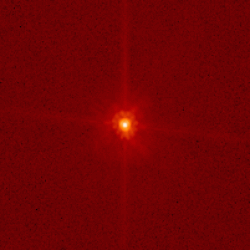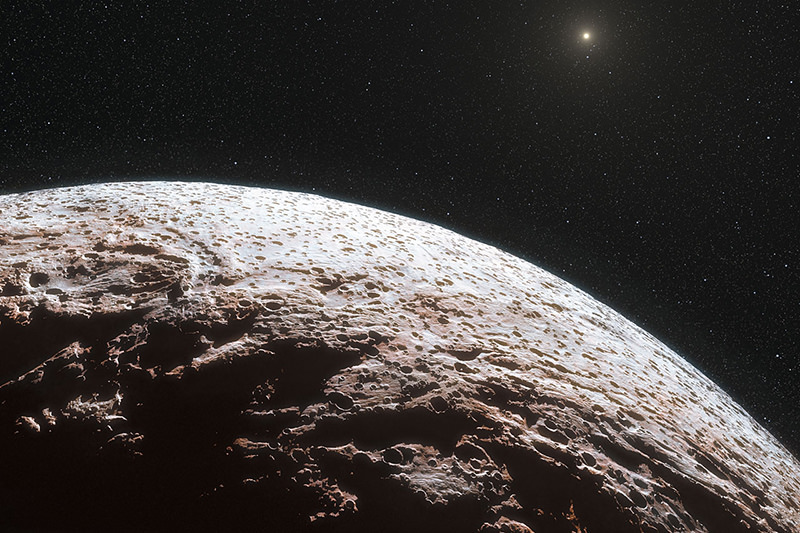Artist’s impression of the surface of Makemake, a dwarf planet beyond Pluto (ESO/L. Calçada/Nick Risinger)
It turns out there’s no air up there: the distant dwarf planet Makemake is surprisingly lacking in an atmosphere, according to findings made by astronomers using telescopes at ESO’s La Silla and Paranal observatories.
An international team of astronomers used the mountaintop telescopes to observe Makemake as it passed in front of a faint background star in April 2011, a brief stellar occultation that lasted only about a minute. By watching how the starlight was blotted out by Makemake, measurements could be made of the dwarf planet’s size, mass and atmosphere — or, in this case, its lack thereof… a finding which surprised some scientists.
“As Makemake passed in front of the star and blocked it out, the star disappeared and reappeared very abruptly, rather than fading and brightening gradually. This means that the little dwarf planet has no significant atmosphere,” said team leader José Luis Ortiz of the Instituto de Astrofísica de Andalucía in Spain. “It was thought that Makemake had a good chance of having developed an atmosphere — that it has no sign of one at all shows just how much we have yet to learn about these mysterious bodies.”
 First discovered in 2005, Makemake is an icy dwarf planet about 2/3 the diameter of Pluto — and 19 AU further from the Sun (but not nearly as far as the larger Eris, which is over 96 AU away.) It was thought that Makemake might have a tenuous, seasonal atmosphere similar to what has been found on Pluto, but it now appears that it does not… at least not in any large-scale, global form.
First discovered in 2005, Makemake is an icy dwarf planet about 2/3 the diameter of Pluto — and 19 AU further from the Sun (but not nearly as far as the larger Eris, which is over 96 AU away.) It was thought that Makemake might have a tenuous, seasonal atmosphere similar to what has been found on Pluto, but it now appears that it does not… at least not in any large-scale, global form.
Due to its small size, sheer distance and apparent lack of moons, making scientific observations of Makemake has been a challenge for astronomers. The April 2011 occultation allowed measurements to be made — even if only for a minute — that weren’t possible before, including first-ever calculations of the dwarf planet’s density and albedo.
As it turns out, Makemake’s albedo is about 0.77 — comparable to that of dirty snow… a reflectivity higher than Pluto’s but lower than that of Eris. Its density is estimated to be 1.7 ± 0.3 g/cm³, indicating a composition of mostly ice with some rock.
“Our new observations have greatly improved our knowledge of one of the biggest [icy bodies], Makemake — we will be able to use this information as we explore the intriguing objects in this region of space further,” said Ortiz.
Read more on the ESO release here.
The team’s research was presented in a paper “Albedo and atmospheric constraints of dwarf planet Makemake from a stellar occultation” to appear in the November 22, 2012 issue of the journal Nature.
Inset image: Makemake imaged by Hubble in 2006. (NASA/JPL-Caltech)


Not the actual titled paper, but relevant nonetheless (PDF): No global Pluto-like atmosphere on dwarf planet Makemake from a stellar occultation.
I can understand Pluto having a tenuous atmosphere because it has 4 satellites (moons) which may induce a small amount of tidal flexing which may release gasses from its crust (my speculation). However, why scientists would expect bodies of this size that are this far from our Sol is beyond me. I am no planetary scientist though…
I think that would be because of its orbit – it goes from 53AU to 38,5AU, so there would be some temperature variations that might produce releasing of gasses. But… Makemake is now at its aphelion, so if that would be the case then they should be frozen on the surface IMO – but I’m not planetary scientist either 😉
Pluto’s atmosphere does vary with the orbital position of the planet. Pluto is moving away from the sun and there are concerns about how much atmosphere will be there when Pluto Express flies by.
It is a bit surprising that any planetary body out this far would have an atmosphere.
LC
The atmosphere is most likely frozen to the surface.
PS- IAU: please rename this KBO. The names are getting downright silly.
I’m sure that Jupiter sounds as ridiculous to the Rapa Nui.
There are no Rapa Nui — they extincted themselves. Apparently “conservation of island resources” sounds strange to them too.
I’m sure that will come as a great surprise to the roughly 6,000 Rapa Nui currently unhabiting Easter Island and mainland Chile.
Speaking of getting downright silly, and a bit problematic considering the impacts on both the remaining indigenous culture and our future handling of the environment, the idea that there was an Easter Island ecocide is a myth.
Why blame anything else than the then usual source of collapse, colonists? Extraordinary claims need extraordinary evidence, instead the little evidence proposed is shown erroneous. What is known is that the Easter Islanders meeting with colonists was as disastrous as elsewhere around the Americas:
“In my initial post on the myths of Easter Island I discussed the conclusions in archaeologists Carl Lipo and Terry Hunt’s new book ‘The Statues That Walked’, which demolished the idea – popularised by Jared Diamond in his book ‘Collapse’ – that Easter Island’s prehistoric society suffered some kind of ecologically-driven collapse which offers a parable for our modern-day environmental problems.” [Mark Lynas, geograph]
“There is no evidence of population decline, let alone “collapse” until after European contact. Indeed, there is direct, abundant evidence that population numbers grew, stabilized, and then fell only after 1722.”
“Easter Island was a story of remarkable success. And as young Native Islanders have told us, knowledge of their ancestors’ success, not failure, matters greatly to them. The “collapse” story for Easter Island is a convenient and popular parable used for shocking the public about the dangers of over-exuberance and environmental disregard. However, as we describe in our book, the island’s collapse came only with the germs, guns, and enslavement brought by the outside world. Given what is at stake in terms of lessons to be learned about long-term survival on an isolated and resource poor location, the truth matters. Indeed, we have much to learn from Easter Island.” [Carl Lipo and Terry Hunt, archaeologists; my bold]
Even today we need to learn how to stop utilizing indigenous populations to feed our endogenous concerns, except in an equitable manner. (I.e. on mutually agreeable terms, such as markets. Trash talking is not that.)
The Liberals took the danged atmosphere. We need to make them shave their body hair
http://www.crowdrise.com/slashthestache